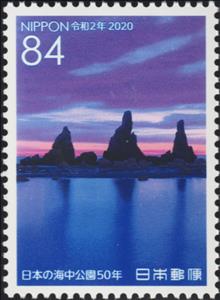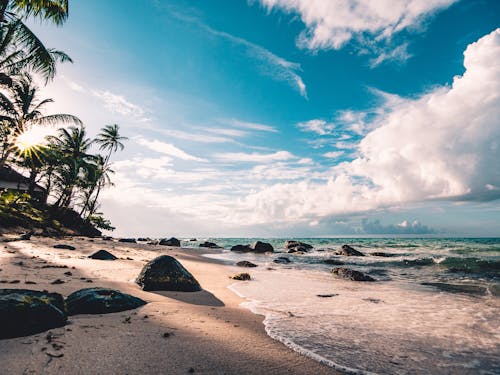Stamp: Yoshino-Kumano National Park (Japan 2020)
Yoshino-Kumano National Park (Japan 2020)
28 January (Japan ) within release 150th Anniversary of National Parks Movement (2020) goes into circulation Stamp Yoshino-Kumano National Park face value 84 Japanese yen
| Stamp Yoshino-Kumano National Park in catalogues | |
|---|---|
| Stamp Number: | Sn: JP 4372h |
| Yvert et Tellier: | Yt: JP 9745 |
| Sakura: | Sak: JP C2443h |
Stamp is vertical format.
stamp from mini-sheet Japanese inscription (below stamp): 吉野熊野国立公園 Transliteration: Yoshino-Kumano Kokuritsu Kōen Japanese inscription (on stamp): 日本の海中公園50年 Transliteration: Nihon no kaichū kōen 50-nen Yoshino-Kumano National Park is a national park comprising several non-contiguous areas of Mie, Nara, and Wakayama Prefectures, Japan.Also in the issue 150th Anniversary of National Parks Movement (2020):
- Stamp - Akan Mashū National Park face value 84;
- Stamp - Oze National Park face value 84;
- Stamp - Chūbu-Sangaku National Park face value 84;
- Stamp - Sanin Kaigan National Park face value 84;
- Stamp - Unzen-Amakusa National Park face value 84;
- Stamp - Sanriku Fukkō Kokuritsu Kōen face value 84;
- Stamp - Ogasawara National Park face value 84;
- Stamp - Yoshino-Kumano National Park face value 84;
- Stamp - Amami Guntō National Park face value 84;
- Stamp - Kerama Shotō National Park face value 84;
- Mini Sheet - 150th Anniversary of National Parks Movement in Japan face value 10*84;
Stamp Yoshino-Kumano National Park it reflects the thematic directions:
An anniversary is the date on which an event took place or an institution was founded in a previous year, and may also refer to the commemoration or celebration of that event. For example, the first event is the initial occurrence or, if planned, the inaugural of the event. One year later would be the first anniversary of that event. The word was first used for Catholic feasts to commemorate saints. Most countries celebrate national anniversaries, typically called national days. These could be the date of independence of the nation or the adoption of a new constitution or form of government. The important dates in a sitting monarch's reign may also be commemorated, an event often referred to as a "Jubilee".
A landscape is the visible features of an area of land, its landforms and how they integrate with natural or man-made features. A landscape includes the physical elements of geophysically defined landforms such as (ice-capped) mountains, hills, water bodies such as rivers, lakes, ponds and the sea, living elements of land cover including indigenous vegetation, human elements including different forms of land use, buildings and structures, and transitory elements such as lighting and weather conditions. Combining both their physical origins and the cultural overlay of human presence, often created over millennia, landscapes reflect a living synthesis of people and place that is vital to local and national identity. The character of a landscape helps define the self-image of the people who inhabit it and a sense of place that differentiates one region from other regions. It is the dynamic backdrop to people’s lives. Landscape can be as varied as farmland, a landscape park, or wilderness. The earth has a vast range of landscapes, including the icy landscapes of polar regions, mountainous landscapes, vast arid desert landscapes, islands and coastal landscapes, densely forested or wooded landscapes including past boreal forests and tropical rainforests, and agricultural landscapes of temperate and tropical regions.
A sea is a large body of salty water. There are particular seas and the sea. The sea commonly refers to the World Ocean, the wider body of seawater. Particular seas are either marginal seas, second-order sections of the oceanic sea (e.g. the Mediterranean Sea), or certain large, nearly landlocked bodies of water.



